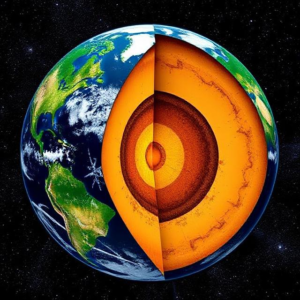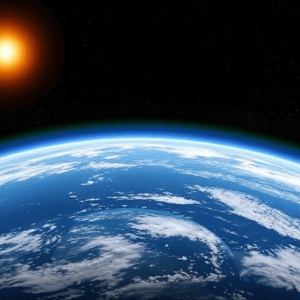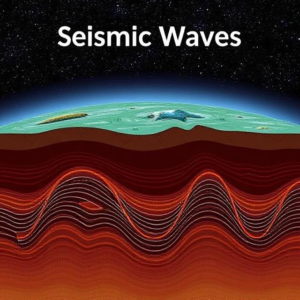Layers of the Earth :
The Earth is made up of four main layers. These layers are like a giant onion, with each one covering the one beneath it. Here’s a simple breakdown:
- Crust (Outer Layer):
- The crust is the thinnest layer of the Earth. It’s the part we live on! It’s made up of rocks and minerals.
- There are two types of crust: the continental crust (under the land) and the oceanic crust (under the oceans).
- The crust is where we find mountains, oceans, and continents.
- Mantle:
- The mantle is the thick layer just below the crust. It’s made up of hot, semi-solid rock that can slowly flow.
- It’s about 2,900 km thick and is divided into the upper mantle (which is mostly solid) and the lower mantle (which is hotter and can flow slowly).
- The mantle is where most of the Earth’s heat is stored, and it causes the movement of tectonic plates that can lead to earthquakes and volcanic eruptions.

- Outer Core:
- The outer core is a layer of liquid metal (mostly iron and nickel) beneath the mantle.
- It’s about 2,200 km thick and is extremely hot (temperatures can reach up to 5,500°C).
- The movement of liquid metal in the outer core helps create the Earth’s magnetic field.
- Inner Core:
- The inner core is the very center of the Earth. It’s a solid ball made of iron and nickel.
- It’s extremely hot, even hotter than the outer core (around 6,000°C), but it remains solid because of the immense pressure at the Earth’s center.
- The inner core is about 1,200 km thick and plays a role in Earth’s magnetic field too.
Layers of the Earth’s Atmosphere
The atmosphere is a layer of gases that surrounds the Earth. It’s divided into five layers based on temperature and altitude:
- Troposphere (Closest to Earth):
- This is where we live and where all the weather happens (clouds, rain, etc.).
- It extends about 8-15 km above the Earth’s surface.
- The temperature decreases as you go higher in this layer.
- The troposphere contains about 75% of the atmosphere’s mass and most of the water vapor.
- Stratosphere:
- This layer lies above the troposphere and extends about 15-50 km above Earth.
- The ozone layer is found here, which protects us from harmful ultraviolet (UV) radiation from the Sun by absorbing most of it.
- In the stratosphere, the temperature increases as you go higher because the ozone layer absorbs heat from the Sun.

- Mesosphere:
- The mesosphere extends from about 50 km to 85 km above the Earth’s surface.
- This is where most meteors burn up when they enter the Earth’s atmosphere.
- In this layer, the temperature decreases as you go higher, making it the coldest layer of the atmosphere.
- Thermosphere:
- The thermosphere extends from about 85 km to 600 km above Earth.
- In this layer, the temperature rises dramatically with height and can reach up to 2,500°C.
- It’s where the Northern and Southern Lights (auroras) occur due to interactions between charged particles from the Sun and the atmosphere.
- The thermosphere also contains the International Space Station (ISS), and satellites orbit here.
- Exosphere (Outermost Layer):
- The exosphere is the outermost layer of the atmosphere, starting around 600 km and extending out to 10,000 km.
- This is where the atmosphere begins to transition into outer space.
- It contains very few particles, mainly hydrogen and helium, and they are so spread out that they can travel hundreds of kilometers before colliding with each other.
- Satellites and spacecraft can travel through this region.
So, in summary:
- The Earth has four main layers: crust, mantle, outer core, and inner core.
- The atmosphere has five layers: troposphere, stratosphere, mesosphere, thermosphere, and exosphere.
Each of these layers plays an important role in keeping the Earth and its environment functional and supporting life!











